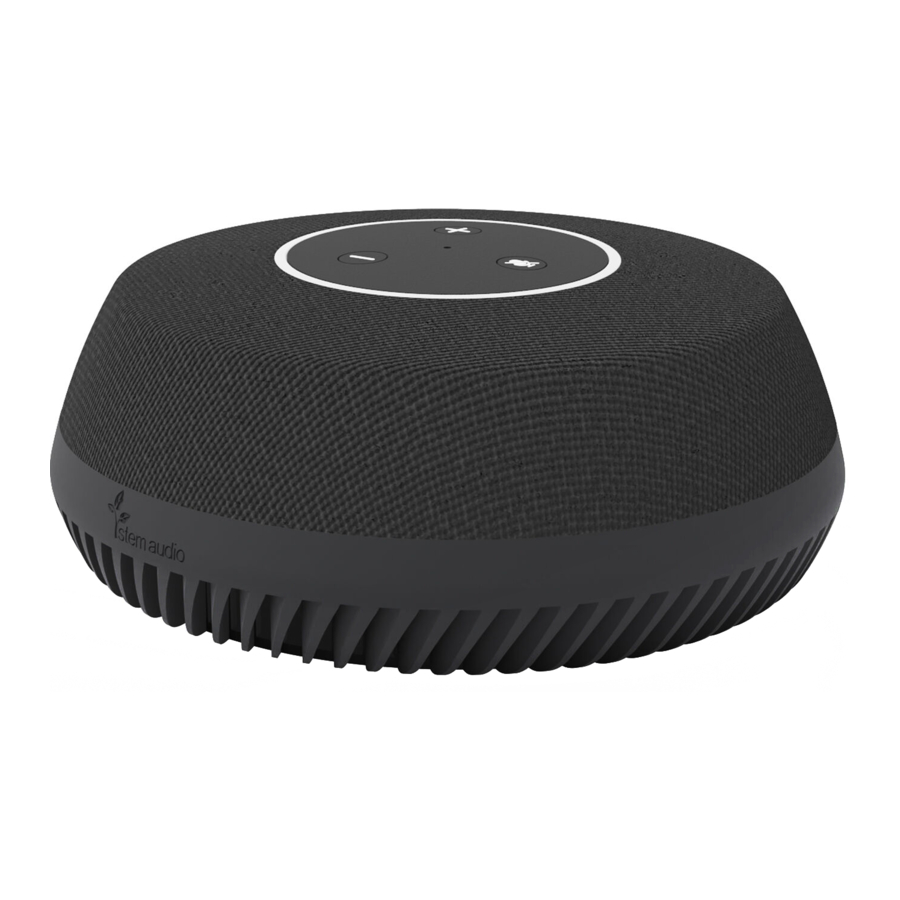Advertisement

Overview
Optimized for tabletops and flat surfaces, the Stem Table is a high-quality conference speakerphone that turns any environment into a professional conference room. Equipped with nine microphones that perform real beamforming and an innovative downward-facing speaker for amplified performance, Table takes the quality of your meetings to the next level.

Setting Up
All Stem endpoints can be used as solo standalone devices or in unison with other devices within the Stem ecosystem. If you plan on using this device as an individual unit, then follow the standalone setup instructions. If you plan on using multiple Stem devices in your room, then skip ahead to the multiple device setup instructions.

Standalone Setup (option 1)
- Place the device in the desired location in the room.
- Using an Ethernet cable, connect the device to a network that supports PoE+. This connection provides the device with power, data, and other IoT and SIP capabilities.
Note: If your network doesn't support PoE+, you should purchase a separate PoE+ injector or PoE+ enabled switch. - If you need video conferencing capabilities, use the USB type B cable provided and connect the device to your PC.
- Lastly, we recommend you complete setting up your room via the Stem ecosystem platform. For more information on setting up your room, you can visit stemaudio.com/manuals or stemaudio.com/videos
Note: The ecosystem platform is available on the Stem Control or in iOS, Windows, and Android apps. You can also access the platform through your web browser by typing in the product's IP address. - That's it! Table is all set up to work as a standalone device.
Multi-Device Setup (option 2)
- Place the device in the desired location in the room.
- Using an Ethernet cable, connect the device to a network that supports PoE+. This connection provides the device with power, data, and other IoT and SIP capabilities.
Note: If your network doesn't support PoE+, you should purchase a separate PoE+ injector or PoE+ enabled switch. - When setting up multiple Stem devices in a room, make sure you have a Hub. All communications between the device and the far-end will be done through the Hub, so no USB connection is needed.
- You must complete setting up your room via the Stem ecosystem platform. For more information on setting up your room, you can visit stemaudio.com/manuals or stemaudio.com/videos
Note: The ecosystem platform is available on the Stem Control or in iOS, Windows, and Android apps. You can also access the platform through your web browser by typing in the product's IP address. - That's it! Table is all set up to work within the Stem ecosystem.
Using Table
The Directional Array
During a call, Table uses proprietary beamforming technology to locate a legitimate voice source and to steer an array towards it. This allows Table to focus on the speaker in the room and cancel out all other noise. The beamforming process is dynamic as it adjusts the direction of the array when the source of sound changes or moves. In a call, when a voice is detected in the room, one or multiple blue lights located in the light ring will indicate which direction Table's audio beam is focusing on. This is the direction that will be heard best by the farend of the call (the person you are talking to).
Volume Control
Speaker
Change the speaker volume by using  to increase, or
to increase, or  to decrease the volume.
to decrease the volume.
Mute
To mute Table's microphones during a call, press  located on the top of the device. When muted, the light ring on the device will slowly pulse red. To unmute, just press
located on the top of the device. When muted, the light ring on the device will slowly pulse red. To unmute, just press  again.
again.
Light Ring Guide
| Light Ring Activity | Device Status |
| Slow red pulsing | Device is muted |
| Rapid red pulsing (approx. two seconds) | Device is being pinged |
| Solid red ring | Device error |
| Single blue light circulating counterclockwise | Device is booting up |
| Full blue ring turning off clockwise | Device is restarting |
| Partial blue ring shifting | Device is adapting & testing the environment |
| Directional blue light | Direction of voice pickup in progress |
Product Specs
Connectors
- USB: USB Type B
- Ethernet: RJ45 connector (requires PoE+)
Specs
- Frequency response: 50Hz – 16KHz
- Broadcast level (peak): 90dB SPL @ 1Khz from 1m (5 watts RMS)
- Noise cancellation: > 15dB (without pumping noise)
- 100% full duplex – no attenuation (in either direction) during full duplex
- High-end performance conforms to ITU-T G.167
- Acoustic echo cancellation: > 40dB with conversion speed of 40dB/sec
- Residual echo is suppressed to the environment noise level, preventing artificial ducking of signal
- Nine high-quality beamforming microphones
- One speaker: 4 watts (RMS)
- Direction-finding algorithm (determines the presence and direction of a speaker) Beamforming algorithm (forms and directs audio beams towards a defined direction)
- Automatic voice-level adjustment (AGC)
- Weight: 2.5 lbs. (1.1 kg)
- Dimensions: Diameter: 7.75 in. (19.7 cm) Height: 3 in. (7.6 cm)
- Power Consumption: PoE+ 802.3 at Type 2
- Operating Systems: Windows 98 and up / Linux / MacOS.
Complies with:
- AS/NZS CISPR 32:2015
- EN 55032:2012/AC:2013
- VCCI 32-1
- FCC 15.109:2019
- FCC 15.109(g):2019
- ICES-003:2016 updated April 2017

The Ecosystem

Need Some Help?
Website: stemaudio.com
Email: customerservice@stemaudio.com
Telephone: (949) 877-STEM (7836)
Product Quickstart Guides: stemaudio.com/manuals
Product Setup Videos: stemaudio.com/videos

Documents / Resources
References
Download manual
Here you can download full pdf version of manual, it may contain additional safety instructions, warranty information, FCC rules, etc.
Advertisement

Need help?
Do you have a question about the Table1 and is the answer not in the manual?
Questions and answers